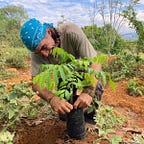Seeds of Bioregional Regeneration
The Earth has an innate capacity to support life. The seeds of regeneration for this special planet lay dormant in its pathway of cosmological development that included being at just the right distance from the Sun, having a companion Moon to mix the oceans, and other key factors that gave rise to complex life.
Among its many life systems has been the emergence of a peculiar mammal with distinctive cultural abilities — including the innate capacities to redirect evolutionary energies away from other species to feed itself. This is what has enabled humans to degrade landscapes all over the planet and drive the Earth into a pattern of overshoot-and-collapse.
Paradoxically, this human capacity to alter landscapes at large scales is the very same ability we can use to regenerate the Earth. If we can degrade landscapes as our cultural systems evolve, it is also possible to design our cultural systems so that they become regenerative.
The study of dispersal patterns for different plant and animal species has shown that ecosystems move and change at large scales that map the biological patterns to their underlying geographic set of constraints. This leads to the emergence of a naturally self-organizing pattern of ecology for what is known as a bioregion. In non-human terms, this refers to the complex interplay of species that give rise to specific “ecotypes” such as coastal estuaries, tropical rainforests, alluvial flood plans, and the living beings they support.
Bioregions are defined around the geologic, climatic, and ecological processes unfolding throughout them — reaching stability at systemic levels only when they function seamlessly as part of watersheds and mountain ranges, island boundaries and coastal shelfs. For humans, there is an added layer of constructing a cultural life system that is well suited to place. Human bioregions are defined where ecology gets mapped to cultural identity among those who “know how to live here” in the landscapes of their birth.
The powerful insight is that bioregions are naturally self-organizing ecological systems that function regeneratively at landscape scales. The seeds of regeneration for the Earth, planted so long ago as microorganisms and the webs of interdependence among them, have evolved into vast complexes of life that we call ecosystems today. They achieve the greatest levels of resilience and biodiversity when held intact at regional scales.
If we are to transform the human presence on Earth as a process of intentional cultural evolution, we will need to actively and consciously organize ourselves into bioregional economies. Luckily, the seeds of this Great Transition were planted in fertile bioregional soils all over the planet more than 50 years ago.
Simply visit the Cascadia Bioregion of the Pacific Northwest to see how rich and diverse its “relocalization” efforts truly are. Drop into a Quechua village high in the Peruvian Andes and you will discover they have retained an indigenous life system that functions well in their place. Visit the managers of water systems in Bhutan to see how they have evolved a set of religious institutions that map onto the effective management of their watersheds.
Go anywhere that humans have lived for extended periods of time and you will discover seeds of bioregional regeneration in the cultural adaptations enabling them to live in that place.
My family is now on a journey to cultivate these seeds of bioregional regeneration. We spent ten months living in the northern mountains of Costa Rica learning about regenerative practices there. Then we took a bike tour through northern Idaho and eastern Washington to see how they function as a region of human ecology. That was followed by visits to Whidbey Island and the city of Bellingham (also in the Pacific Northwest) to engage in community dialogue around regenerative design in the context of planetary collapse.
Now we are preparing for a three month sojourn in Colombia to help a local community set up their own bioregional learning center. We hope to be cross-pollinators in the co-evolution of places around the planet where the cultural seeds have been preserved as permaculture practices, libraries of native species, histories of indigenous lifeways, and embodied knowledge for how to live in each place.
What are you doing to seed bioregional regeneration where you live?
Onward, fellow humans. ❤
Joe Brewer is the executive director of the Center for Applied Cultural Evolution. Get involved by signing up for our newsletter and consider making a donation to support our work.
